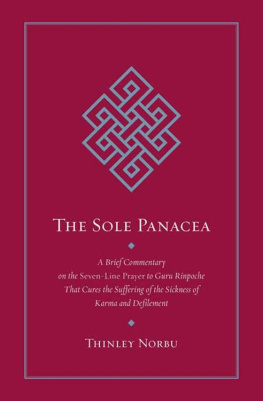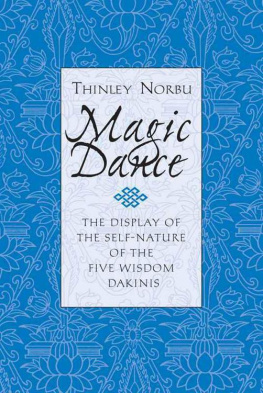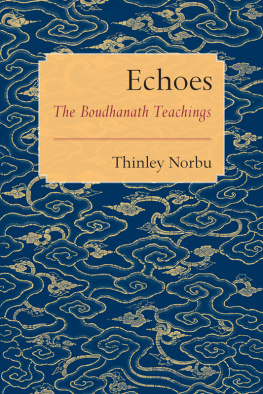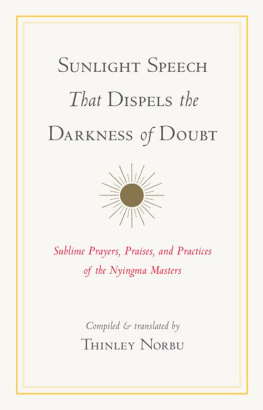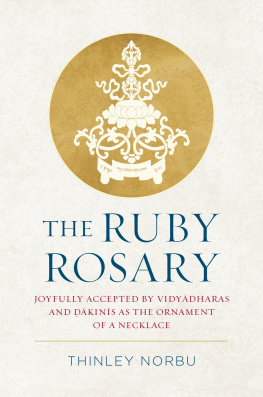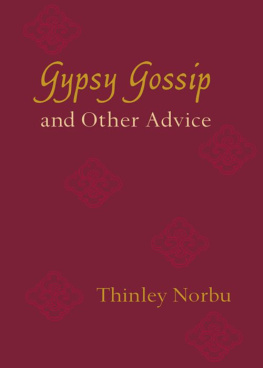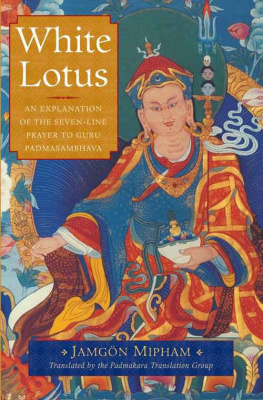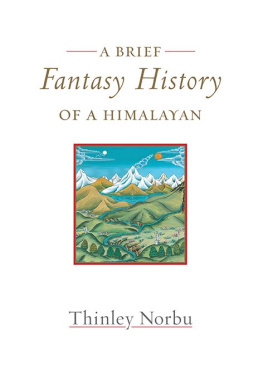ABOUT THE BOOK
The moment you invoke me, I, Padmasambhava,
Have no choice but to come to bless you.
Of all the heartfelt devotional prayers used as a support for Dharma practice, the Seven-Line Prayer is the most essential, often repeated many thousands of times by practitioners, especially of the Nyingma and Dzogchen traditions of Tibetan Buddhism. This concise prayer invokes the blessings of Padmasambhava, also called Guru Rinpoche (Precious Teacher) and known as the Buddha of our time. Guru Rinpoche brought the Dharma from India to Tibet in the eighth century and is the source of Dzogchen, the Great Perfection teachings that awaken the enlightened nature of ones own mind.
Although the prayer is short and simple, its different levels of meaning make this commentary a welcome study aid for practitioners. Kyabje Thinley Norbu Rinpoche provides an account of the historical origin of the prayer and the power of its blessings, and comments on its two levels of meaning: one, according to the common Mahayana teachings; the other, according to the uncommon Dzogchen realizations. He repudiates various mistaken interpretations and clarifies a number of important philosophical views and meditation methods. The book also includes the text of the Seven-Line Prayer in English and Tibetan.
THINLEY NORBU Rinpoche (19312011) was a preeminent teacher in the Nyingma school of Tibetan Buddhism. The eldest son of His Holiness Ddjom Rinpoche, he was a primary holder of the Ddjom Tersar lineage and considered to be an emanation of Longchenpa, the great fourteenth-century Nyingma master.
Sign up to receive weekly Tibetan Dharma teachings and special offers from Shambhala Publications.

Or visit us online to sign up at shambhala.com/edharmaquotes.
The Sole Panacea

A Brief Commentary on the Seven-Line Prayer to Guru Rinpoche That Cures the Suffering of the Sickness of Karma and Defilement
T HINLEY N ORBU

SHAMBHALA
Boston & London
2014
S HAMBHALA P UBLICATIONS , I NC .
Horticultural Hall
300 Massachusetts Avenue
Boston, Massachusetts 02115
www.shambhala.com
2013 by the Estate of Kyabje Thinley Norbu Rinpoche
All rights reserved. No part of this book may be reproduced in any form or by any means, electronic or mechanical, including photocopying, recording, or by any information storage and retrieval system, without permission in writing from the publisher.
L IBRARY OF C ONGRESS C ATALOGING-IN- P UBLICATION D ATA
Thinley Norbu, author.
The sole panacea: a brief commentary on the Seven-Line Prayer to Guru Rinpoche that cures the suffering of the sickness of karma and defilement / Thinley Norbu.First edition.
pages cm
eISBN 978-0-8348-3006-6
ISBN 978-1-55939-439-0 (hardback: alk. paper)
1. Tantric BuddhismDoctrines. 2. Spiritual lifeTantric Buddhism. I. Title.
BQ8918.3.T48 2014
294.3923dc23
2013039408
Contents
The preliminary writings, containing answers to questions others have asked:
A brief explanation of the beliefs of various doctrines of eternalism and nihilism, which depend on the temporary circumstances of the agreement or disagreement of phenomena and objects of phenomena.
A brief explanation of the reason that wanting to understand the immaterial, absolute nature of mind with the help of material scientific technology is building a castle of sand, which can never be reliable; and how important it is to actually believe in the three supports of worship and holy places, mountains, and caves.
A few words dispelling doubts about the controversy that has circulated discriminating between Padma Jungne who came to Tibet and Padmasambhava.
A brief explanation of the claim that Jatsn Nyingpo is the only fully ordained tertn, and how this contradicts both Buddhas speech and logic.
A brief explanation of the views of the various doctrines of Buddhism.
A brief explanation of the various ways of recognizing the Triple Gems, the object of refuge, in the common and uncommon vehicles.
A brief explanation of the way that Hnayna does not accept Mahyna, and the Mahyna reply that clears this contradiction. Also, a summary of the various beliefs of the higher and lower vehicles.
The definition of Chomdend and the histories of peaceful and wrathful deities, which completes the brief preliminary topics.
The main writings about the Seven-Line Prayer:
A historical account of the origin of the Seven-Line Prayer and the greatness of its blessings.
The pure mindfulness of practicing the outer meaning of the Seven-Line Prayer .
Regarding the practice of the inner meaning of the Seven-Line Prayer:
During the basis, there are seven ordinary consciousnesses.
During the path, there are seven branches of enlightenment.
During the result, there are seven absolute treasures, with an explanation of how they are perfected.
Receiving the four empowerments and the practice of dissolution connected with it.
Sustaining the nature of awareness.
Transcending thoughts and appearances to arrive in wisdom.
Completed with the dedication of merit.
Publishers Note
This book contains special characters. If you encounter difficulty displaying these characters, please set your e-reader device to publisher defaults (if available) or to an alternate font.
BY T ULKU T HONDUP
The Buddha of Infinite Light of Sukhavati, the Buddha of Compassion of Potala, and
The Lord of Lotus of the Jambu continentalthough you appear separate for beings,
You are united in the glorious Lotus Born Buddha, the enlightened action of the three Kayas,
Who is extraordinarily kind to the people of the Land of Snow. To you I pay homage.
KUNKHYEN LONGCHEN RABJAM
K YABJE D UNGSE T HINLEY N ORBU R INPOCHE (19312011) was a celebrated scholar and an eminent adept of the Nyingma tradition of our age. He was the eldest body, speech, and mind son of His Holiness Dudjom Rinpoche (19041987). Dungse Rinpoche was a reincarnation of the great terton Tulku Drime Ozer (18811924), who was one of the eight brilliant sons of Terchen Dudjom Lingpa. Tulku Drime is known as a reincarnation of Kunkhyen Longchen Rabjam (13081363), the foremost celebrated master of the Dzogpa Chenpo lineage. Longchen Rabjam, in turn, was the reincarnation of Princess Padmasal (eighth century) to whom the profound teachings known as the Heart Essence of the Dakinis (Khandro Nyingthig) of Dzogpa Chenpo were entrusted by Guru Rinpoche, Padmasambhava, in person at Samye Chimphu in the presence of her father, King Thrisong Deutsen of Tibet.
One of the many precious writings that Dungse Rinpoche bequeathed to his followers was the present volume, The Sole Panacea .
According to many ter texts, or mystically revealed teachings, the dakinis sang the Vajra Seven-Line Prayer to invoke Guru Rinpoche, Padmasambhava, in the pure lands of the Knowledge-holders. In India, when devotees sang it at the famous Nalanda University, Guru Rinpoche miraculously appeared and pacified obstacles. In the eighth century, Guru Rinpoche gave this prayer to his disciples in the Himalayasas the prayer to invoke his blessings, as the meditation to awaken their own wisdom realizations, and as the means of uniting all as one with the ultimate pure nature. Later, starting from Guru Chwang (12121270) until the present day, almost all the one hundred major tertons and the one thousand minor tertons have revealed this same Vajra Seven-Line Prayer in their ter discoveries. For over a millennium throughout the Nyingma world of the Himalayas, huge assemblies of devotees in monasteries, nunneries, and villages, or solitary yogis in high mountains, deep forests, and nomadic camps, have been singing it in enchanting melodies or in the boundless sound of silence. These roaring waves of the Vajra Seven-Line Prayer , prompted by the waves of their hearts of devotional energy, have caused the boundless wisdom of the primordial nature to blossom throughout the ages.
Next page
